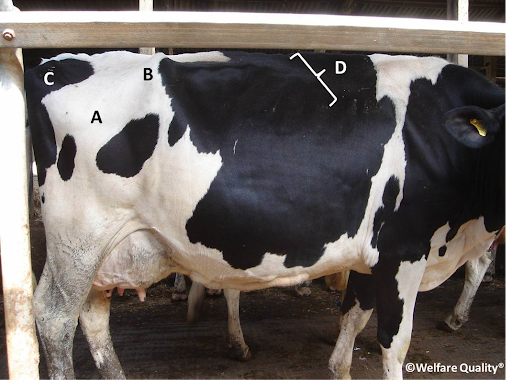Completion requirements
View
Condition scoring is done to see if cattle are healthy enough for breeding and production – or if stockmen suspect that animals are sick. Checking and scoring the condition of cattle is not difficult but requires some experience.
Click on the link/s below to open the resources.
Condition Scoring of Cattle and Sheep

Animal Condition Scoring
An examination of an animal should be done systematically and thoroughly, e.g. from top to bottom, and then from left to right.
- Look at the head of the animal. Does it have a nasal discharge? Are its eyes clear and alert? Are there cuts or injuries? Are there any swellings? Is the head held normally, or drooping or bent down? Are the eyes bright, clear, and shiny, or are they red, opaque, or weeping? Are the ears alert or drooping? Is there frothing at the mouth or an excess of saliva? Are the mucous membranes around the eye pale, yellow, blue, or dark red?
- Examine the animal’s neck. Are there any abscesses? Is there a swelling (oedema) under the jaw? Open wounds? Are the lymph nodes swollen?
- The back. Is the back level sturdy? Does it sag excessively? Is the coat in good condition? Shiny or dull? Does the animal have dandruff? Are there mites or lice? Are there bite marks or lick marks on the coat? Are there patches of hair missing? Is the skin loose or tight, soft or hard?
- Rump. Are the hip bones sticking out excessively? Do a condition scoring.
- Shoulder. Are there any cuts, bruises, etc?
- Ribcage. Are the ribs well covered with the flesh? Are they moving rapidly, shallowly, and hardly at all?
- Rumen and intestines. Can you hear any rumen movement (gurgles)? When you palpate the rumen is it hard, or floppy? Is the rumen bloated?
- Reproductive organs (male and female). Check for ticks around all reproductive organs. If a female: is there a vaginal discharge? Is the vulva swollen and red? Is the ewe in pain when she urinates? If a male: are the testicles the same size? Is the penis normal, does it have sores? Is the prepuce infected?
- Front limbs. Are the legs stiff? Is the animal lame?
- Hind limbs. Are the legs stiff? Is the animal lame?
- Hooves. Are they the right length? Are there any ticks between the hooves? Does the animal have any infections between the hooves?
- Is the animal by itself, or with the rest of the herd/flock? Is it alert, or dull and unresponsive? Is it breathing normally? Is it coughing? Is it shivering? Is it eating and drinking normally? Is it ruminating normally?
- Is it standing up or lying down? Is it lying normally?
- Examine the faeces and urine. Are the faeces normal or abnormal (is there diarrhoea, mucous or blood)? Is the urine pale yellow, brown or red? Does the animal strain to pass urine or faeces?
- Recognise pain in the animal. Is the animal bellowing or bleating? Is the animal restless? Does it grind its teeth? Is it grunting? Is it licking a lot? Is it kicking itself, if so, where?
- What to look for in lactating animals. Are either or both teats inflamed, swollen, and tender? Are the teats injured? Does the milk contain milk clots? Is the milk blood-stained? Has the milk yield fallen?